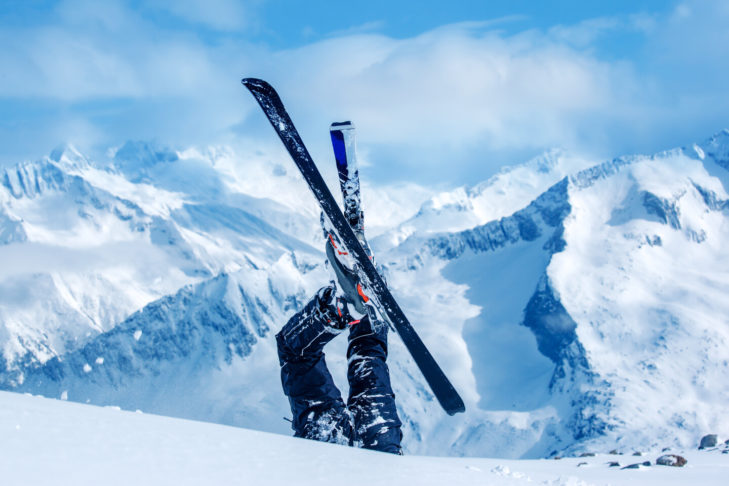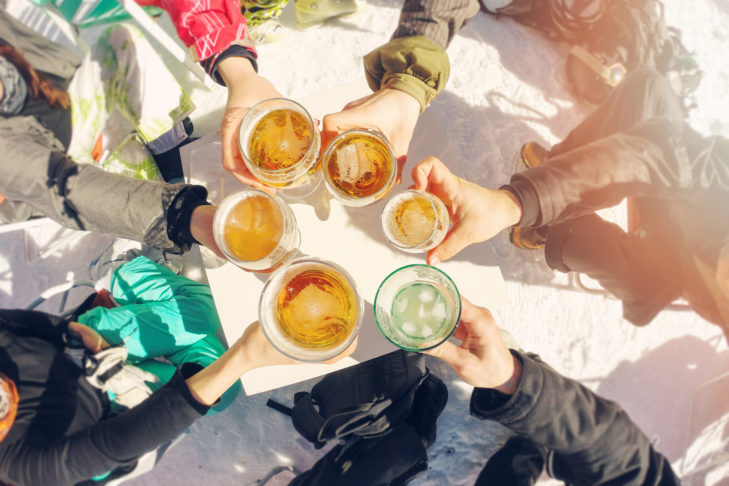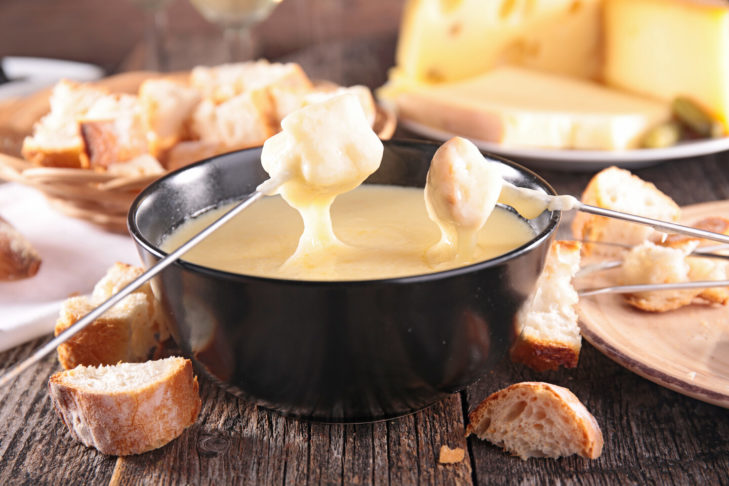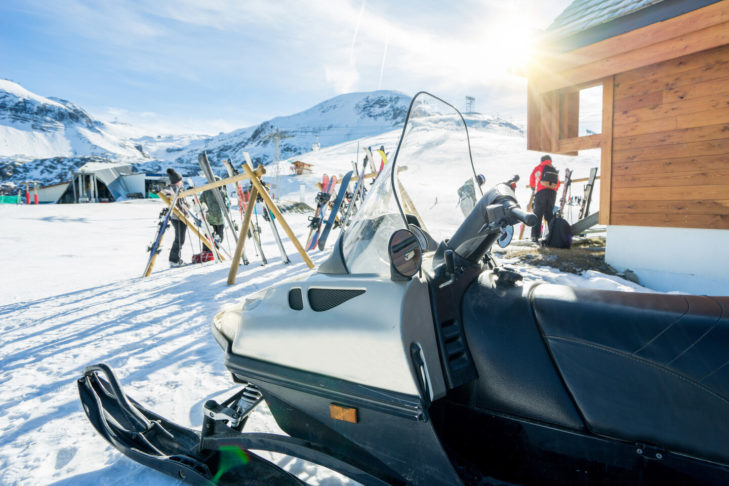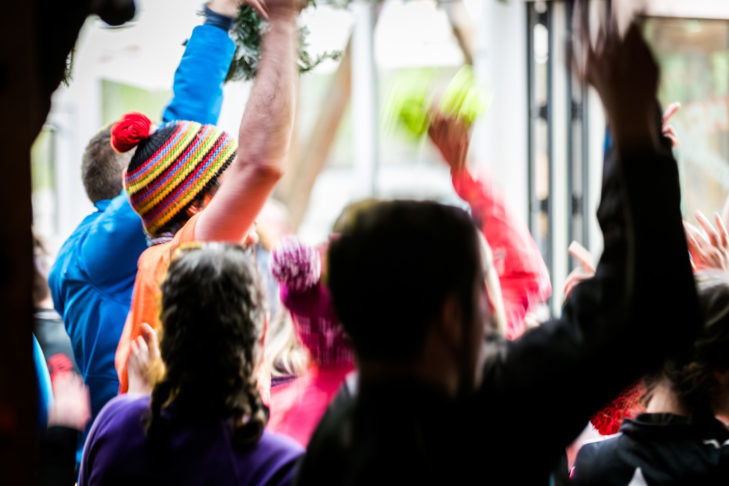Après-ski is as much a part of winter sports as poles are to skis. But what began a good hundred years ago as a social get-together after skiing has degenerated into wild alcoholic excesses for some. This can have not only physical but also legal consequences. However, neither serious accidents nor expensive legal proceedings are necessary if winter sports enthusiasts take a responsible approach to après-ski fun. SnowTrex shows how this can be done.
From hearty potato soup to a wild party
Après-ski comes from the French and translates roughly as “after skiing”. It refers to the entertainment programme at ski resorts in the evening. The origins of après-ski go back to the middle of the 19th century. In Telemark, Norway, the tradition of socialising after a day on the slopes became established. People usually met up with friends for dinner in their own homes. A typical après-ski meal at this time was a hearty potato soup, accompanied by the obligatory aquavit.
A few decades later, the custom reached the Alps. In 1893, the Glarus Ski Club in Switzerland offered an après-ski programme for the first time. This was so popular with winter sports enthusiasts that the evening entertainment programme quickly spread throughout the entire Alpine region. Nowadays, après-ski ranges from restaurants to après-ski bars and live music with the best hits to discos. Winter sports enthusiasts can choose from a wide range of options, offering everything from cosy dinners to wild parties that go on until the early hours of the morning. Après-ski is a great way to get to know other winter sports enthusiasts, to relax after a strenuous day’s sport and, of course, to simply have fun.
But in many places, après-ski also means a lot of alcohol. High alcohol consumption in particular can have serious consequences. Hungover or even drunk skiers can cause serious accidents. According to surveys by the Austrian Road Safety Board, as many as 20 per cent of skiers are out on the slopes with more than 0.5 per mille. This not only leads to unnecessary injuries, but can also be prosecuted under certain circumstances.
Alcohol on the piste endangers yourself and others
Everyone should be aware of the consequences alcohol consumption has on the body. On the one hand, you put yourself at risk. For example, alcohol can lead to hypothermia more quickly because it dilates the blood vessels. This means that the blood flows faster and the body releases more heat. Under the influence of alcohol, you therefore don’t notice that you are getting cold as quickly.
Alcohol also dehydrates the body. This makes you tired and reduces alertness. In addition, people act more recklessly under the influence of alcohol as it lowers risk awareness. Finally, the ability to coordinate and concentrate is greatly reduced under the influence of alcohol. In dangerous situations, you can no longer react quickly enough, which leads to falls and accidents more quickly.
Alcohol also impairs our vision, as our eyes send information to the brain. This in turn forms a 3D image from which we can not only recognise the object, but also obtain information on dimensions and distance. When skiing, this is important information in order to coordinate skiing on the slopes without accidents. Alcohol disrupts this very complex process, which means that we no longer recognise things accurately or only in a blurred way. As with driving, alcohol is therefore a safety risk on the piste.
Drunk skiing is not a criminal offence, but it can have legal consequences
The International Ski Federation (FIS) therefore states very clearly in its guidelines: winter sports enthusiasts must exercise caution and consideration on the piste. The first FIS rule states that winter sports enthusiasts must behave in such a way that they do not endanger themselves or others. The second rule states that skiers must always ski in a controlled manner. Anyone who skis while drunk or intoxicated is usually not doing either and is therefore in breach of the FIS rules.
However, although these rules apply to winter sports enthusiasts worldwide, they are not law. Unlike driving a car, it is not a criminal offence to ski while drunk. There may be consequences, such as being banned from the piste. While neither drinking alcohol nor skiing while drunk is illegal, in the event of an accident, the FIS rules will be applied in court proceedings and the consumption of alcohol will be taken into account when determining guilt.
So if an accident occurs and someone wants to litigate, this can have consequences in both civil and criminal proceedings. If the court decides that the skier acted negligently by drinking alcohol and violated the FIS guidelines, he may be found solely at fault.
In 2011, for example, the Munich Higher Regional Court ruled that, in addition to disregarding several FIS rules, the high alcohol consumption of the skier in question had also led to an accident with a piste groomer and that he was therefore to blame for the accident.
Responsible après-ski
What does all this mean for behaviour at après-ski? Is it best not to drink at all? As with many things, it’s all about moderation: Anyone who starts their après-ski with a glass or two of sparkling wine at breakfast and then hits the piste is clearly acting irresponsibly. Think of it this way: remember that après-ski means after skiing, so as long as you’re skiing, don’t be drinking alcohol.
But for après-ski after a day’s skiing, one or two glasses is perfectly acceptable. Of course, this is only a rough guideline. Because how much alcohol is too much alcohol depends primarily on the following factors: Gender, amount of alcohol, type of drink and the contents in your stomach.
Women can tolerate less alcohol than men
Women tolerate less alcohol than men. This is because the proportion of fat in the body is higher in women and the proportion of fluid is lower than in men. As fat does not absorb alcohol, the alcohol is distributed over less fluid in women. The result is a higher concentration of alcohol in the blood, even if a woman weighs the same as a man.
Not all alcohol is the same
How quickly alcohol goes to your head also depends on the type of drink. For example, caution is advised with cocktails and the popular warm alcoholic drinks at après-ski, such as mulled wine, Jägertee or the typical Swiss coffee Lutz.
This is because warm alcohol enters the bloodstream a little faster than cold alcohol and therefore goes to the head more quickly. Added to this are the sugary substances that are added to warm alcoholic drinks and cocktails. These also ensure that the alcohol enters the bloodstream more quickly. Another danger is that the sweet mixed drinks mask the flavour of the alcohol, which means that you unconsciously drink more.
There are of course also differences in alcoholic drinks that are not mixed. For example, a glass of beer contains less alcohol (around 5 per cent alcohol content) than a cup of mulled wine (up to 14.5 per cent). Ultimately, however, the amount of alcohol is the decisive factor for the alcohol content in the blood and how it is absorbed in the stomach through food.
Creating a basis
Even though après-ski traditionally takes place before dinner, you can also simply turn the tables. After all, there is definitely something to the saying that you should “build a base” before drinking. If you eat a greasy, high-calorie meal before drinking, it makes it harder for the alcohol to get into your bloodstream. This could be a rich cheese fondue, dumpling or pasta dishes, oily fish or fried potatoes, for example.
During après-ski partying, it is also advisable to drink a glass of water after every glass of alcohol. This helps the alcohol to enter the bloodstream more slowly and prevents the typical dehydration caused by alcohol. Small snacks such as nuts or soup also help the body to process the alcohol better.
Despite all caution, you should always make sure that you never drive under the influence of alcohol. This is illegal and dangerous everywhere. One glass of mulled wine can be too much. If in doubt, it is safer to leave the car parked and take a taxi back to the hotel. Some après-ski venues offer a shuttle service back to the hotel, which can also be a good alternative for the way home.
National law applies on the piste
But what happens if you ski drunk on the piste despite all precautions and an accident occurs? The specific criminal consequences of consuming alcohol or the amount of compensation for damages are assessed according to national law.
As the FIS rules apply internationally, judges around the world use them as a benchmark when deciding who is at fault in an accident. In addition, penalties naturally always depend on the individual case and the specific circumstances.
For example, the alcohol content in the blood, the type and severity of the damage and the exact behaviour of the winter sports skier that led to the accident are assessed. A distinction is made between different levels of negligence in both civil and criminal law.
For example, in German criminal law, “conscious negligence” means that the person was aware from the outset that they could cause damage, but nevertheless did not stop the action. In the case of “unconscious negligence”, it is assumed that the person causing the damage had no bad intentions and did not realise that an accident could have happened. Those who act with intent even want to deliberately cause harm to other people. These gradations of negligence vary between criminal and civil law as well as by country.
In Switzerland, for example, Swiss citizens can have certain insurance benefits reduced. In the event of a personal accident, the daily allowance insurance is reduced. If others are injured, personal liability insurance is reduced and the person responsible for the accident must pay for the damage out of their own pocket.
In Germany, accidents on the ski slopes under the influence of alcohol can even lead to prison sentences of up to ten years in addition to civil law compensation payments.
In Italy, where the police are responsible for safety on the slopes, the most common consequence for drunk skiing without accidents is a fine. Officers also ensure that drunk winter sports enthusiasts are escorted off the piste safely.
However, most piste operators and even the police are against alcohol checks or alcohol bans when skiing. In fact, skiing accidents caused by drunk winter sports enthusiasts are very rare. This is due to better pistes, better equipment and, above all, the increasing health and responsibility awareness of winter sports enthusiasts. This is why piste operators and the police prefer to limit themselves to random checks when someone has obviously had too much to drink.
Hangovers: the overlooked danger
However, in addition to this focus on drunk skiing, another danger is often overlooked: the hangover the morning after. Of course, anyone who wants to can party hard one night. But then it should also be clear that you won’t be hitting the piste the next day. Because even those who ski after a night of drinking are putting themselves and others at risk. The “hangover” the next morning is often underestimated. In fact, the “hangover” also affects the body and brain.
In addition to ethanol, alcoholic drinks also contain so-called higher alcohols, which are even more toxic and remain in the body for longer. During a hangover, the body processes these higher alcohols. This leads to tiredness, pain in the neck and back as well as headaches and nausea. Skiing is not only very unpleasant, but also impairs concentration. Accidents can therefore happen much more quickly. It is therefore safer for everyone if you are not on the piste.
But if you drink in moderation, don’t exceed your own limits and avoid the piste when in doubt, you can have fun both skiing and après-skiing.
Après-ski needs to be well planned
A good start to a successful après-ski day can be, for example, to end the day of skiing with a lavish dinner. Afterwards, you can take things slowly and start with a hot chocolate or tea (with a shot).
If you then switch to alcohol, you should be careful with cocktails or hot mixed drinks and not drink several glasses in a row. After the mulled wine, a glass of water is recommended, then perhaps a small snack before switching back to alcohol. This way you don’t have to miss out on the delicious après-ski drinks and still drink responsibly. You can then return to the hotel by bus, taxi or shuttle.
Another good après-ski tip is to start early and finish early. That way, you’ll still get enough sleep after après-ski and be fit and rested for the piste the next morning.
Après-ski is a great tradition to round off a day on the piste in a cosy atmosphere. But if you don’t want to endanger yourself or others, take it easy when it comes to alcohol consumption. There’s nothing wrong with two or three glasses of beer after skiing. However, wild alcoholic excesses can easily lead to accidents – even the next day – and even have criminal consequences. So the rule is: drink in moderation and you’ll have more fun!
FAQ’s on après-ski
Where does après-ski come from?
Après-ski comes from the French and translates as “after skiing”. It refers to the socialising after skiing. The tradition dates back to the 19th century and began in Telemark, Norway.
What are the dangers of drinking alcohol and skiing?
Alcohol impairs several bodily and brain functions. We see less clearly, our coordination deteriorates, we are not focussed and we quickly overestimate our abilities. All of this increases the likelihood of accidents on the piste. Not only can you injure yourself, but also others.
Is drunk skiing illegal?
No. Unlike driving a car, there is no law regulating the drink-drive limit when skiing. Nevertheless, you are putting yourself and others at risk and are also breaking the International Ski Federation’s rules of behaviour. If there is also an accident, the added factor of drunkenness can have a negative impact on the penalty.
What legal consequences can drunk skiing have?
If drunk skiing leads to an accident, the question of fault/guilt will be determined under both criminal and civil law. In criminal proceedings, penalties can range from fines to prison sentences. In civil proceedings, the guilty party must pay compensation for any damage caused.
Are there national differences in penalties?
The question of guilt depends on the degree of negligence. This is defined differently in civil law and criminal law. There are also national differences. Accordingly, the penalties can vary from country to country. In addition to the general legal aspect, individual factors such as alcohol content and the type and severity of the damage also play a role in the penalty.
What influences the blood alcohol level?
How alcohol is processed in the blood depends on gender, the amount of alcohol consumed and the type of drink. What you have eaten beforehand also influences how quickly alcohol is broken down. Women reach higher blood alcohol content levels than men with lower amounts of alcohol, warm alcohol goes to the head more quickly and fatty, high-calorie food provides a good basis.
Should you give up après-ski altogether?
No! Après-ski is part of winter sports and is a great way to end a day’s skiing in a cosy atmosphere and meet other winter sports enthusiasts. But you should be responsible: If you’ve had too much to drink, you shouldn’t drive a car. It is also better not to ski the next day if you have a hangover. In addition, the rule of behaviour is: if you ski, don’t drink.



